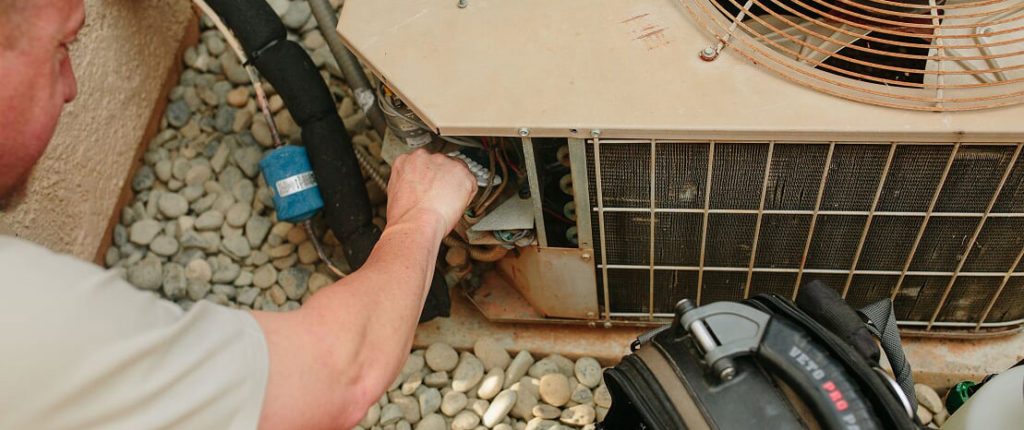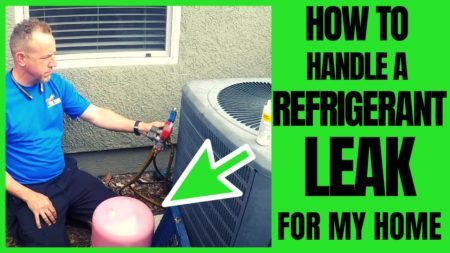If your HVAC technician tells you your A/C has a refrigerant leak, I want to tell you how we handle that here at Fox Family Heating and Air Conditioning.
The Environmental Protection Agency has updated the requirements related to ozone-depleting and global warming substances like R-22 and R-410, a refrigerant that’s very likely in the HVAC system at your house.
So, how do we handle a refrigerant leak at your home? After some recent schooling online and some back and forth, I found that we can’t REQUIRE you to fix the leak in residential applications that have less than 50 lbs. of refrigerant or less. This likely describes your system. We’re not and you’re not required to find or fix your leaking HVAC system. This means that if you wanted to gas it up and repeatedly let that refrigerant leak out, you’re apparently not forbidden to do that.
Fox Family’s Position
We at Fox Family have strong feelings about continuing to allow the release of harsh chemicals that contribute to the degradation of our planet, namely the ozone layer, as well as other contributors to global warming. We also want future generations of plants, animals, and humans to have a chance to enjoy their lives, breathe clean air, and thrive!
Here’s what happens when your system leaks. Large amounts of CFC’s, HFC’s and HCFC’s (which is what refrigerant is) are spewing into the atmosphere every day. Industrial and commercial buildings are the main culprit, but far more homes than commercial buildings exist. Regardless, leaking refrigerants mix with wind currents, air pressure and updrafts, bringing those chemicals into the lower atmosphere. No matter what people say about chlorine being heavier than air, it’s been proven several times over that these chemicals are amply mixed with our lower and upper atmosphere where they linger.
Unfortunately, rain doesn’t bring them down. As those chemicals rise even further through updrafts and pressure differences in the air, high energy solar radiation breaks down those chemicals, releasing the damaging chlorine. Those chlorine particles stay in the stratosphere for several years, where it eats away at the ozone layer.
Having a Conversation
But back to your refrigerant leak. Some HVAC companies can and do continue to come out and refill your refrigerant for as long as you need it, because face it, you need to be comfortable. I get it! But at some point, a Fox Family technician is going to have a conversation with you about finding that leak and coming up with a plan to repair the leak or change out your system. It’s the right thing to do.
So, do we “gas and go” year after year? Two to three times at your house is perhaps our limit. If you don’t want to fix it, your love for the planet may not be in line with ours. HVAC companies make pretty good money by selling you refrigerant. It’s easy labor for us, and not very time consuming either. That’s why it’s called “gas and go.”
Refrigerant Leak Searching
But refrigerant is expensive. If you’ve got to keep refilling your refrigerant, who knows how often, it can really add up quickly. If we’ve been to your home before, then we have a baseline from which to draw our information. But if it’s our first time out, it would be unfair to you for us to recommend you start a leak search immediately.
What if it’s just a loose Schrader core at the service valve where the technicians hook their gauges up? I’ve seen this before. The system was way low on charge, and when I took the cap off the service valve, it was slowly shooting liquid refrigerant into the air. I tightened the core and the system hasn’t leaked out since, or at least they haven’t called me back yet. But it’s a start.
Striking a Balance
As an HVAC company, we’re damned if we do, and damned if we don’t. If we say you need a leak search the first time out, people may think we’re being pushy sales-techs. If we don’t and they leak out again, we might be criticized for not recommending a leak search at our earlier call. These people will later want us to come back out and replace the leaked-out refrigerant for free.
Other times, we come upon an R-410 system made between 2008 and 2015 that’s leaking. It has copper coils which we know did NOT mix well during that time of production. If it’s an Aspen or ADP coil, I know exactly where to go every time to find that leak: in the evaporator coil near the furnace. If I pop the cover off and look low on the two slabs of the A-coil, I’ll always find oil staining the coils, or an oily feel to the bottom of the primary drain pan, under the evaporator coil. Sometimes, with a quick look into the p-trap, I’ll see the oily water right there in the PVC. An easy fix!
The Customer’s Role
But you know your system’s history better than us. Our customers must help us out by letting us know if they’ve had another company come out and charge their system up. If you have a big leak, we could refill your refrigerant today, and it will be gone by tomorrow. Because they’re not liable for your system’s performance, most companies aren’t going to provide a complimentary refill just to get you up and going. They know it’s just going to leak out again.
Some companies will put some sort of leak stopper fluid into the lines. It’s a lot like that green slime they put in bicycle tires to find the leak and plug the hole from the inside. Once again, about half of the HVAC guys out there will tell me I’m wrong, but I won’t put that stuff in your system, because it can clog up the metering device at your evaporator coil, and now I’m on the hook for your TXV not working right.
A lot of manufacturers will agree with me when I say nothing should be in your refrigerant lines besides virgin refrigerant. At the most, we’ll insert some dye so we can come back later and identify where the leak is. But that’s only after we come out and use an electronic sniffer and visually check the system for leaks.
Refrigerant Leak Searching: How It’s Done
Let’s say you’ve decided to find the leak so we can figure out what to do next. Fox Family’s leak searches come in 3 stages:
Stage 1: Inspection
A stage 1 leak search includes an inspection of the condenser and evaporator coils as well as the line set that runs in between for leaks. We will use vision, soap bubbles, and/or an electronic leak detection device. This searching process can last for up to an hour. What will this process cost? If the necessary repair is easily accessible, the price of the repair and leak search will be covered for the price of the stage 1 leak search. You’ll be liable for your refrigerant refill one last time. But we always put the cost of the leak search towards the cost of your repair.
Stage 2: Using Refrigerant Dye
If we can’t find it that way, we go on to a stage 2 leak search. This means adding refrigerant dye to the system and returning in about a month. This allows the refrigerant to circulate through the system. The dye will spray out of the leak along with the refrigerant and oil. The small spot left behind provides a visual of the leak location. The cost of this stage 2 leak search will also go towards the total cost of the leak repair. We almost always find it in this case.
Let me respond to the people out there who say, “I thought only virgin refrigerant was supposed to be in the lines.” It’s always good practice to recover any remaining refrigerant in the lineset, put on a new filter drier, and evacuate the system properly. No matter how small or where the leak was, the system surely lost some of its vacuum during this leak. In my opinion, just pumping the system down and releasing the charge isn’t really good practice.
Stage 3: Pressure Testing
If we still can’t find the leak, a stage 3 leak search is available. It requires us to isolate the 3 portions of the refrigeration tubing from each other. We separate the outdoor coil, the indoor coil, and the line set that runs in between. Fox Family brazes on a valve stem to these pieces of equipment. The technician then pressure tests each one individually in order to find which one is leaking. This stage of leak search is very costly and is very rarely ever used. It also takes a lot of time on the owner’s part as well as the technician. Because it requires that we leave the system isolated for days at a time, it can be uncomfortable for the homeowner in the middle of summer.
Summary
This summarizes how Fox Family Heating and Air Conditioning handles a leak search. Other companies will handle it in their own unique way. I hope this sheds some light on the process used by Fox Family for our customers who’ve asked.
If you have any questions, comments or concerns, please feel free to leave them down below in the comments section. This always sparks conversation, as methods for dealing with leaking systems vary quite a bit from contractor to contractor.
Thanks so much for stopping by, and we’ll see you next time!
Fox Family Heating & Air serves Sacramento, Rancho Cordova, and all of Northern California. If you’re looking to schedule HVAC service in these areas, give us a call!



